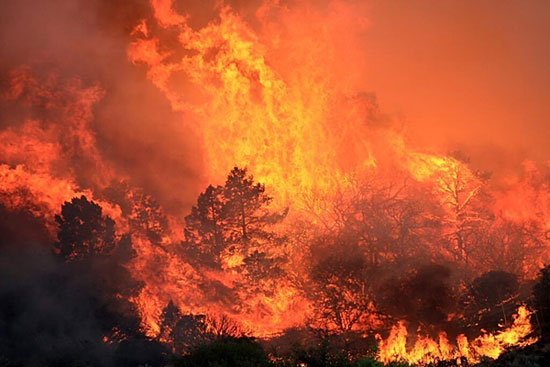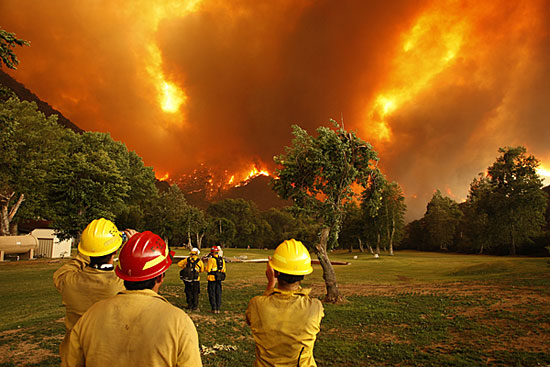Raising the alarm on fire perils
June 25, 2013
Record levels of parched vegetation, along with a long-running drought and predictions of hot, dry weather ahead have prompted fire officials to issue an unusually sharp warning about this year’s fire season:
It’s on a fast and furious pace—and may hold dangers unlike anything we’ve seen before.
Los Angeles County Fire Chief Daryl Osby, appearing with other fire officials this week, said indications add up to “probably the most volatile fire season that’s projected based on our 100-year history.”
Osby said in an interview that recent fires in Ventura County and in northern Los Angeles County have already provided a dramatic wakeup call that is mirrored statewide, where 500 early season fires have taken place so far this year.
Because the county hasn’t experienced a wildland fire on the massive scale of the Station Fire since 2009, Osby said, there’s plenty of highly flammable dead brush out there—in some areas, 100 years’ worth. What’s more, with rainfall totals running well below normal, measurements by the county fire department’s Forestry Division show that the amount of moisture in live brush has already fallen to critically dry levels, months ahead of schedule.
The Santa Clarita area hit the critical threshold of 60% “live fuel moisture” in May—meaning that the brush is so dry it will burn, in effect, like a dead plant. The rest of the county is expected to cross that dangerous threshold by the first of July, a good two months ahead of schedule.
“Sixty percent in the middle of May—that’s unheard of,” said Frank Vidales, acting chief of the Forestry Division.
Those conditions, coming in the midst of a three-year drought, are disrupting traditional fire patterns and throwing a curve to even the most experienced firefighters.
When some of them reported back from the frontlines of the Powerhouse Fire in the Angeles National Forest, which charred more than 30,000 acres, they told Osby:
“I’ve never seen that kind of fire behavior in my career. It sounded like not one, but two locomotives coming through.”
What was particularly worrisome about the blaze, Osby said, was that it was whipped up by ordinary winds off the ocean—not the fierce Santa Anas of autumn.
“That’s not typical. Typically at this time of year, we’ve still got a lot of moisture and a lot of green fuel out there,” Osby said. “That fire almost acted like the type of fire that we’d get in the fall—and that was just with normal winds off the ocean.”
To prepare for the challenges of such “extreme fire behavior” as the season progresses, county fire officials are preparing to fight back swiftly at the first sign of trouble.
“Regardless of the boundaries, we’ll try to get our resources there as quickly as we can to keep it from growing large. That’s our philosophy this year,” Osby said.
To that end, they’re moving up the schedule for bringing in the extra air power that traditionally comes into town during fire season. Super Scooper aircraft that usually arrive from Canada in mid-September are now projected to fly in around Sept. 1, and a heavy-lift helicopter is tentatively slated to report for duty on Aug. 1.
There’s also a rethinking of tactics underway.
“In some instances, based on projections and especially based on weather, it may be safer just to evacuate communities and come in afterward and try to save homes, rather than stay in there and try to defend it,” Osby said. “Because the last thing we want to do is put our firefighters in extreme danger, or our citizens.”
The heightened dangers of a volatile fire season also require more public vigilance. That means clearing brush around houses and other structures, getting familiar with the fire department’s Ready!Set!Go! program, and being aware that 94% of wildfires are set by people, sometimes intentionally but more often inadvertently with sparks from lawn mowers, weed whackers, power tools or even welding.
Finally, if a fire evacuation order is issued, residents should be ready to heed it—fast—regardless of whether they’ve toughed it out and stayed put through similar situations in years gone by.
“Psychologically, because they’ve experienced it in the past, they might say, ‘Well, we lived through this before; we can do it again.’ But it’s really important for our citizens to realize that this is not a typical fire season,” Osby said. “You’re not going to have your typical fire behavior. It’s going to be very volatile and when we ask them to evacuate, they need to evacuate early…Because your property can be replaced. Your life can’t.”

The Powerhouse Fire, above, is an early harbinger of the volatile fire season ahead. Photo/L.A. County Fire
Posted 6/20/13













 405 bridge work causes a stink
405 bridge work causes a stink
